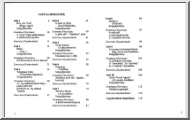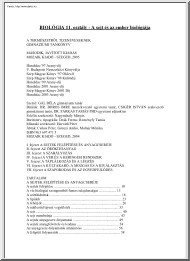No comments yet. You can be the first!
Content extract
MANAGING CHANGE 1. WHAT PROBLEMS ARE ASSOCIATED WITH CHANGE? A) Factors influencing change Potential causes: Economic/ resource shortage Legislative/ governent Competition/ marketforces Technical/ technological Educational/ expectations Sociological/ consumerism B) Some possible actions: Training/ retraining Communicating/ involving Job enrichment Career planing Re-establishing loyalty Education/ re-education 2. PLANNING AND IMPLEMENTING CHANGE A) Why do people resist change? Insecurity (status job, differentials) Fear of criticism Loss of collegues/ workmates Difficulity of learning new skills Los of job interest B) Planning change Develop a clear vision Idetify significant steps in the change process Comunicate the staged plan to all concerned Inspire confidence by forestalling problems and by regular commnication C) Helping people accepting change Consider how
they will be affected? Plan change carefully Involve the in the change Consult and inform frequently Be firm butflexible Make contorversial change as gradualy as possible Monitor the change Develop the ’change’ philosophy 3. LEWIN’S UNFREEZE/ CHANGE/ REFREEZE MODEL A) Definition This model defines three stages in the process of change. It assists organisational change by: Allowing the process to be understood Providing milestones for evaluating progress towards thechange Being able to be usedfor all types of change It does not prescribe: Thenatureof the change The speedif thechange The number and type of people involved in the change The eventaloutcome of the change B) Processes Unfreezing Develop the awerness of: o The nature of the change needed o The ethods planned to achieve thevchange o The needsof those affected o The ways that progress will be planned and monitored Changing o Defining problems o Identifying solutions o Implementing
solutions Refreezing o Stabilzing the situation o Building and rebuilding relationships o Consolidating the systems C) Benefits The model can be easily understood Those undergoing the change process can recognise thestage they have reached It allows the process to change to be discussed as well as the outcomes Understading the process in one change makes for easier progress in the future change
they will be affected? Plan change carefully Involve the in the change Consult and inform frequently Be firm butflexible Make contorversial change as gradualy as possible Monitor the change Develop the ’change’ philosophy 3. LEWIN’S UNFREEZE/ CHANGE/ REFREEZE MODEL A) Definition This model defines three stages in the process of change. It assists organisational change by: Allowing the process to be understood Providing milestones for evaluating progress towards thechange Being able to be usedfor all types of change It does not prescribe: Thenatureof the change The speedif thechange The number and type of people involved in the change The eventaloutcome of the change B) Processes Unfreezing Develop the awerness of: o The nature of the change needed o The ethods planned to achieve thevchange o The needsof those affected o The ways that progress will be planned and monitored Changing o Defining problems o Identifying solutions o Implementing
solutions Refreezing o Stabilzing the situation o Building and rebuilding relationships o Consolidating the systems C) Benefits The model can be easily understood Those undergoing the change process can recognise thestage they have reached It allows the process to change to be discussed as well as the outcomes Understading the process in one change makes for easier progress in the future change




 Just like you draw up a plan when you’re going to war, building a house, or even going on vacation, you need to draw up a plan for your business. This tutorial will help you to clearly see where you are and make it possible to understand where you’re going.
Just like you draw up a plan when you’re going to war, building a house, or even going on vacation, you need to draw up a plan for your business. This tutorial will help you to clearly see where you are and make it possible to understand where you’re going.